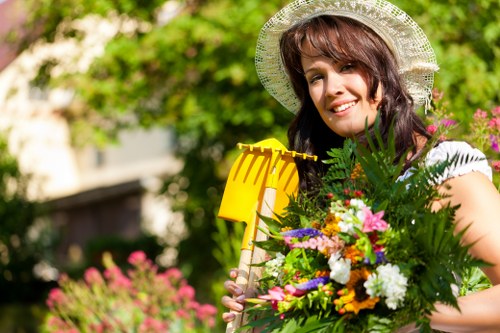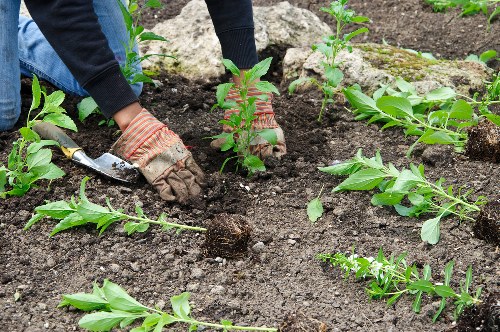Garden Fence Installation Manor House

Installing a garden fence around your manor house is more than just a functional decision; it's a choice that enhances the property's aesthetic appeal and provides security. A well-installed fence can define your garden space, offer privacy, and add to the overall charm of your historic manor.
When considering a garden fence installation, it's essential to select materials and designs that complement the architectural style of your manor house. Whether your manor boasts a classic Victorian design, a Tudor aesthetic, or a modern twist, the right fence can accentuate its unique features.
Moreover, the installation process should be meticulous to ensure the fence not only looks good but also stands the test of time. Factors such as soil condition, weather exposure, and maintenance requirements play a crucial role in choosing the right fence type.

Choosing the Right Fence Material
One of the first decisions in garden fence installation is selecting the appropriate material. Different materials offer varying levels of durability, maintenance, and visual appeal.
Wooden Fences: Wooden fences are a popular choice for manor houses due to their natural beauty and versatility. They can be painted or stained to match the manor’s exterior and come in various styles, from picket to lattice designs.
Metal Fences: Metal fences, such as wrought iron or aluminum, provide a more formal and sturdy option. They are low-maintenance and can be intricately designed to add a touch of elegance to your garden.

Design Considerations
The design of your garden fence should harmonize with the manor house's architecture and the surrounding landscape. Consider the following design elements:
- Height: The fence height affects privacy and security. For a manor house, a taller fence might be suitable to ensure privacy from neighbors.
- Style: Choose a style that reflects the manor's character, whether it's ornate, simple, or modern.
- Color: The fence color should complement the manor's color scheme and the garden's flora.
Additionally, incorporating features like gates and railings that match the main fence can create a cohesive look throughout the property.

Installation Process
Proper installation is key to ensuring the longevity and functionality of your garden fence. Here’s a step-by-step overview of the typical installation process:
- Planning: Assess the perimeter of your garden, measure the area, and decide on the fence layout and design.
- Permits: Check local regulations and obtain any necessary permits for fence installation.
- Preparation: Clear the installation area of any debris and mark the fence line.
- Foundation: Dig post holes at regular intervals and set the fence posts securely in concrete.
- Installation: Attach the fence panels or individual boards to the secured posts.
- Finishing Touches: Apply any paint or stain, and install gates and other decorative elements.

Maintenance Tips
Maintaining your garden fence ensures it remains attractive and functional for years to come. Regular maintenance tasks include:
- Cleaning: Remove dirt, debris, and organic matter to prevent decay, especially for wooden fences.
- Inspection: Regularly check for signs of damage, such as rot, rust, or loose boards.
- Repairs: Promptly address any issues to prevent further deterioration. Replace damaged panels or repair loose posts as needed.
- Painting/Staining: Reapply paint or stain periodically to protect the fence from weather elements and maintain its appearance.
Proper maintenance not only extends the life of your fence but also preserves the beauty and value of your manor house.
Local Regulations and Permits
Before embarking on garden fence installation near a manor house, it's crucial to understand and comply with local regulations. These regulations can vary depending on the area and may include restrictions on fence height, materials, and placement.
Obtaining the necessary permits ensures that your fence installation is legal and avoids potential fines or the need to remove the fence later. Additionally, if your manor house is a listed or historic property, there may be additional guidelines to preserve its character.
Consulting with local authorities or a professional fence installer familiar with local laws can streamline the permit acquisition process and ensure your project adheres to all requirements.
Enhancing Curb Appeal
A well-installed garden fence can significantly enhance the curb appeal of your manor house. By choosing designs and materials that complement the architectural style, your fence becomes an integral part of the property's overall aesthetic.
Consider incorporating decorative elements such as finials, lattice work, or ornamental panels to add character and sophistication. Additionally, well-planned landscaping alongside the fence, including climbing plants or flowering shrubs, can create a stunning visual impact.
Investing in high-quality materials and professional installation ensures that your fence not only looks beautiful but also remains a lasting feature of your manor's landscape.
Security and Privacy
Beyond aesthetics, a garden fence provides essential security and privacy for your manor house. A sturdy fence deters unwanted visitors and creates a safe environment for family members and guests.
For added security, consider fences with higher panels, secure locks on gates, and features like barbed wire or anti-climb designs if necessary. Privacy can be enhanced by choosing solid materials that block visibility, ensuring that your outdoor spaces remain secluded.
A balance between security and visual appeal can be achieved by selecting designs that are both functional and attractive, maintaining the elegant appearance of your manor while providing peace of mind.
Local Expertise and Services
Choosing a local contractor with experience in garden fence installation near manor houses ensures that your project benefits from regional knowledge and expertise. Local professionals are familiar with the area's architectural styles, climate considerations, and regulatory requirements.
They can provide personalized recommendations tailored to your manor house’s specific needs, from material selection to design customization. Additionally, local installers often offer more responsive customer service and can address any issues promptly.
Investing in a reputable local contractor not only supports the community but also ensures that your garden fence installation is executed with precision and care.
Cost Factors
The cost of garden fence installation around a manor house varies based on several factors. Understanding these factors can help you budget effectively and make informed decisions.
- Material: Different materials come at varying price points. For instance, wooden fences may be less expensive than wrought iron options.
- Length and Height: The total length and height of the fence directly impact the overall cost. Longer and taller fences require more materials and labor.
- Design Complexity: Intricate designs with decorative elements or custom features can increase labor costs.
- Terrain: Uneven or challenging terrain may require additional groundwork, affecting the installation cost.
- Permits and Regulations: Obtaining necessary permits may involve fees that should be factored into your budget.
Obtaining multiple quotes from reputable contractors and clearly defining your project’s scope can help you manage costs effectively while ensuring quality installation.
Sustainability Considerations
In today's eco-conscious world, sustainability plays a significant role in garden fence installation. Selecting environmentally friendly materials and practices can minimize your project's ecological footprint.
Recycled Materials: Opting for fences made from recycled or sustainably sourced materials contributes to environmental preservation. Bamboo, recycled metal, and reclaimed wood are excellent choices.
Durability: Choosing long-lasting materials reduces the need for frequent replacements, conserving resources and minimizing waste.
Eco-Friendly Finishes: Using non-toxic stains, paints, and sealants ensures that harmful chemicals do not leach into the environment, protecting both your garden and local wildlife.
Professional vs. DIY Installation
Deciding between professional installation and a DIY approach depends on your skill level, budget, and the complexity of the project.
Professional Installation: Hiring experienced professionals ensures that the fence is installed correctly and efficiently. Professionals bring expertise in design, material selection, and adherence to local regulations, resulting in a high-quality finish.
DIY Installation: If you possess the necessary skills and tools, a DIY project can be cost-effective. However, it requires careful planning, time investment, and the ability to troubleshoot potential issues that may arise during installation.
For manor house settings, where aesthetics and durability are paramount, professional installation is often the preferred choice to achieve the desired outcome.
Impact on Property Value
A well-installed garden fence can enhance your manor house's property value by improving its curb appeal and functionality. A stylish and sturdy fence appeals to potential buyers and can make your property stand out in the market.
Moreover, practical benefits like added security and privacy are attractive features that contribute to a higher perceived value. Investing in quality materials and professional installation ensures that the fence remains a valuable asset to your property over time.
Local Recommendations
In the Manor House area, there are several neighborhoods where garden fence installation is particularly popular. Here are some of the closest and most notable areas:
- Oakwood Manor: Located just 2 miles from Manor House, Oakwood Manor features traditional architecture, making wooden and wrought iron fences a top choice.
- Pinecrest Estate: 3 miles away, Pinecrest Estate residents prefer elegant metal fences that complement their lush gardens.
- Maple Grove: Situated 4 miles from Manor House, Maple Grove homeowners favor sustainable and eco-friendly fence materials.
- Willowbrook: 5 miles distant, Willowbrook offers a mix of historic and modern homes, leading to diverse fence styles.
- Elmwood Park: At 6 miles from Manor House, Elmwood Park is known for its spacious gardens, often encased in high privacy walls.
- Birch Hill: Located 7 miles away, Birch Hill’s scenic views inspire the use of decorative fences that blend with the natural surroundings.
- Cedar Heights: 8 miles from Manor House, Cedar Heights residents prioritize durable materials that withstand varying weather conditions.
- Sycamore Field: Situated 9 miles away, Sycamore Field homeowners often choose fencing that provides both security and aesthetic appeal.
- Magnolia Terrace: 10 miles distant, Magnolia Terrace’s elegant homes are complemented by classic fence designs.
- Chestnut Ridge: At 11 miles from Manor House, Chestnut Ridge is favored for its blend of traditional and contemporary fence styles.
Conclusion
Garden fence installation for a manor house is a significant investment that enhances both the beauty and functionality of your property. By carefully selecting materials, designs, and professional installers, you can ensure that your garden fence becomes a lasting and valuable feature of your manor.
Consider local regulations, sustainability, and maintenance requirements to make informed decisions that align with your aesthetic preferences and practical needs. A well-installed fence not only provides security and privacy but also elevates the overall charm and value of your historic manor house.
Whether you opt for a classic wooden fence, an elegant metal design, or an eco-friendly option, the right garden fence will beautifully frame your manor house and create a serene and secure outdoor sanctuary.
Frequently Asked Questions
1. What is the best material for a garden fence around a manor house?
The best material depends on your manor house's architectural style and your specific needs. Wooden fences offer natural beauty and versatility, while metal fences like wrought iron provide durability and an elegant appearance. Composite materials are also a great eco-friendly option.
2. How tall should my garden fence be for optimal privacy?
For maximum privacy, a fence height of at least 6 feet is recommended. However, local regulations may dictate specific height restrictions, so it's essential to check with your local authorities before installation.
3. Do I need a permit for garden fence installation near my manor house?
Permit requirements vary by location. It's important to consult with local building authorities to determine if a permit is needed for your specific fence installation project.
4. How long does a garden fence typically last?
The lifespan of a garden fence depends on the materials used and the level of maintenance. For example, wooden fences may last 15-20 years with proper care, while metal fences can last 30 years or more.
5. Can I install a garden fence myself, or should I hire a professional?
While DIY installation is possible for those with the necessary skills and tools, hiring a professional ensures that the fence is installed correctly and complies with local regulations. For manor houses, professional installation is often recommended to achieve the desired aesthetic and durability.